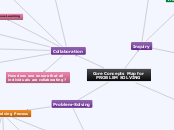Core Concepts Map for PROBLEM SOLVING
Collaboration
How does one ensure that all individuals are collaborating?
How does one ensure that all individuals are getting the most out of their collaboration experience?
Do we need to have personal goals or intended outcomes before participating in CI to ensure we are getting the most out of our experience with CI? Does this need to be a personal thing before it can be a collaborative thing?
Is it possible for each individual to take part equally or does someone take the lead and bare the load of work over others?
THE IMPORTANCE OF BUY-IN!!!
THE IMPORTANCE OF SHARED VISION!!!
THE IMPORTANCE OF A WELCOMING LEARNING ENVIRONMENT!!!
THE IMPORTANCE OF BEING HEARD!!!
Participation is mandatory
Synchronous
Same Goal
Continuous Learning
Learning New Strategies
Inquiry
Seven Characteristics
1. Relevant
2. Collaborative
3. Reflective
4. Iterative
5. Reasoned
6. Adaptive
7. Reciprocal
Problem Solving & Inquiry
These two processes are much the same in terms of: Having a question, planning out how to solve it, researching, creating a solution, improving the solution, then presenting the solution.
Inquiry Process
1. Question
2. Plan
3. Research
4. Create
5. Improve
6. Present
Design - Collaborative Inquiry: A Facilitator's Guide
Stage 1: Framing The Problem
Identify student need
Setting proximal goals and timelines
Shared vision for all collaborators
How do we ensure that those who do not have a shared vision will collaborate?
Stage 2: Collecting Evidence
Identify where to collect the evidence or data and how
Stage 3: Analyzing Evidence
Five Steps: Organize your data; Read; Describe; Classify; Interpret... REPEAT!
Stage 4: Celebrating and Sharing
Celebrate your learning and findings!
SHARE YOUR FINDINGS TO THOSE WHO WERE NOT A PART OF THE PROCESS!!
Problem-Solving
Problem-Solving Process
1. Analyze the Problem
2. Imagine Solutions
3. Plan a Solution
4. Apply the Solution
5. Evaluate the Solution
6. Improve the Solution
7. Implement the Solution
How does one ensure that the Problem-Solving Process is being used effectively through collaboration?
Problem-Solving Questions
Ill-structured Questions
Questions that do not have a specific outcome or a solution to get to the outcome. They are questions that people face day to day, that need to be implemented more within our education system. Ill-structured questions allow for critical thinking and allow for students to flounder and try different methods or solutions to get to a desirable outcome.
Well-structured Questions
Questions that have a specific outcome and a specific solution that is required to get there. Students are forever being exposed to these types of questions and are assessed on these types of questions. This type of problem-solving questions do not prepare students for real-world situations, but rather prepare them for standardized testing and assessment marking.
How can a teacher ensure that they are providing an equal balance of ill-structured questions and well-structured questions to ensure that students are using their critical thinking skills, and to be better prepared for the real-world?
